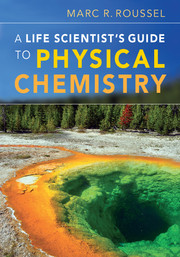Book contents
- Frontmatter
- Contents
- Preface
- 1 Orientation: what is physical chemistry about?
- Part One Quantum mechanics and spectroscopy
- 2 A quick tour of quantum mechanical ideas
- 3 Spectroscopy
- Part Two Thermodynamics
- Part Three Kinetics
- Appendix A Standard thermodynamic properties at 298.15 K and 1 bar
- Appendix B Standard reduction potentials at 298.15 K and 1 bar
- Appendix C Physical properties of water
- Appendix D The SI system of units
- Appendix E Universal constants and conversion factors
- Appendix F Periodic table of the elements, with molar masses
- Appendix G Selected isotopic masses and abundances
- Appendix H Properties of exponentials and logarithmic functions
- Appendix I Review of integral calculus
- Appendix J End-of-term review problems
- Appendix K Answers to exercises
- Index
2 - A quick tour of quantum mechanical ideas
from Part One - Quantum mechanics and spectroscopy
Published online by Cambridge University Press: 05 June 2012
- Frontmatter
- Contents
- Preface
- 1 Orientation: what is physical chemistry about?
- Part One Quantum mechanics and spectroscopy
- 2 A quick tour of quantum mechanical ideas
- 3 Spectroscopy
- Part Two Thermodynamics
- Part Three Kinetics
- Appendix A Standard thermodynamic properties at 298.15 K and 1 bar
- Appendix B Standard reduction potentials at 298.15 K and 1 bar
- Appendix C Physical properties of water
- Appendix D The SI system of units
- Appendix E Universal constants and conversion factors
- Appendix F Periodic table of the elements, with molar masses
- Appendix G Selected isotopic masses and abundances
- Appendix H Properties of exponentials and logarithmic functions
- Appendix I Review of integral calculus
- Appendix J End-of-term review problems
- Appendix K Answers to exercises
- Index
Summary
The objective of this chapter is to go over a few of the basic concepts of quantum mechanics in preparation for a discussion of spectroscopy, which is in many ways the business end of quantum mechanics, at least for chemical scientists. We will also need a few quantum mechanical ideas from time to time in our study of thermodynamics and of kinetics.
Why should we learn quantum mechanics at all? Atoms and molecules are small, and their constituent parts, electrons, protons and neutrons, are even smaller. Early in the twentieth century, we learned that small things don't obey the laws of classical mechanics. A different kind of mechanics, quantum mechanics, is required to understand chemistry on a fundamental level. In fact, we need different mechanical theories to treat extremes of both size and speed. Figure 2.1 summarizes the situation. There isn't a sharp cut-off between the various sectors of this diagram. Also note that some of the theories are more general than others. We could in principle use quantum mechanics or general relativity to predict the trajectories of tennis balls, but it just isn't worth the effort, given that classical mechanics works perfectly well in this range of masses and speeds. On the other hand, classical mechanics doesn't give very good results for things that are either extremely large, or small, or fast.
Like it or not, to discuss phenomena on an atomic scale, we need quantum mechanics. Ordinary (non-relativistic) quantum mechanics is generally adequate, although electrons in heavy atoms sometimes reach relativistic speeds (approaching the speed of light, c), requiring relativistic quantum mechanics.
- Type
- Chapter
- Information
- A Life Scientist's Guide to Physical Chemistry , pp. 7 - 22Publisher: Cambridge University PressPrint publication year: 2012



